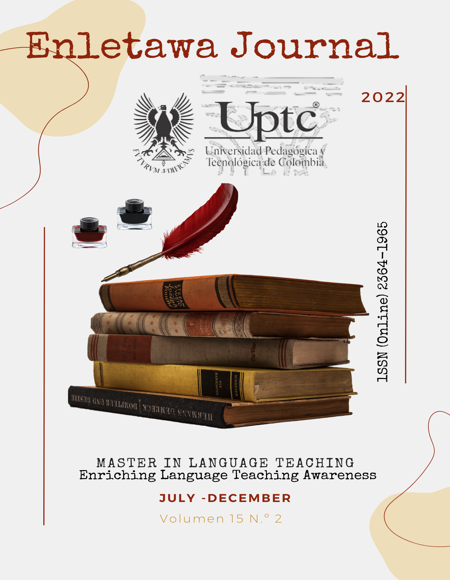Les marionnettes: une stratégie pour développer l’expression orale en français

Resumen
L’objectif de cet article est de présenter les résultats d’un projet de recherche, dans le cadre d’une recherche-action, réalisé dans le but d’explorer comment l’utilisation des marionnettes influence le développement de l’expression orale en FLE chez les élèves de CE1 d’une école privée à Tunja. Cette étude a émergé d’un diagnostic réalisé précédemment, où la nécessité de travailler l’expression orale a été mise en évidence. Une série d’ateliers de langue a permis de créer une interaction entre la marionnette et les étudiants. Pour la collecte des données, ont été utilisés trois outils : un journal de terrain, un portfolio et une vidéo finale. L'analyse des données a permis de trouver l'effet favorable des marionnettes sur une meilleure utilisation du lexique, des phrases courtes faisant des interactions simples répondant et posant des questions, leur permettant de s'exprimer avec plus de sécurité et de confiance. En plus, les élèves ont fabriqué leurs propres marionnettes et ont appris à les jouer. Enfin, on discute des effets de la marionnette chez les étudiants comme outil pour développer leur expression orale.
Palabras clave
Expression orale, marionnettes, interaction, enfants, outil didactique
Biografía del autor/a
Vitalia Pachón Achury
Magíster en Educación-Didáctica de las lenguas Extranjeras, Universidad Libre de Colombia. Grupo de investigación JOIE, Uptc. Docente de francés y práctica pedagógicas,
Diego Mauricio Camargo Vargas
Egresado Licenciatura en Lenguas Extranjeras con énfasis en inglés y en francés, Uptc
Angela Rocío Castro Herrera
Egresada Licenciatura en Lenguas Extranjeras con énfasis en inglés y en francés
Citas
- Alrabadi, E. (2011). Quelle méthodologie faut-il adopter pour l’enseignement/apprentissage de l’oral? Didáctica. Lengua y Literatura, (23), 15-34. http://dx.doi.org/10.5209/rev_DIDA.2011.v23.36308. DOI: https://doi.org/10.5209/rev_DIDA.2011.v23.36308
- Bores, M et Camacho, L. (s.d.) Criterios para evaluar la expresión oral y escrita en la clase de E/LE. Princeton University y University of Texas at Dallas.
- Catroux, M. (2002). Introduction à la recherche-action: modalités d’une démarche théorique centrée sur la pratique. Openedition. 8-20. Pris de https://journals.openedition.org/apliut/4276. DOI: https://doi.org/10.4000/apliut.4276
- Coba, E. et Rodríguez Urrea, J. (2017). La radio : un outil pour fortifier l’expression orale en anglais. [Mémoire pour obtenir le diplôme de licence en Langues étrangères, Université Pédagogique et Technologique de Colombie].
- Conseil de l’Europe. (2001). Cadre européen commun de référence pour les langues: Apprendre, enseigner, évaluer. Strasbourg: Unité des Politiques linguistiques.
- Éduscol. (2002). Portfolio, définition. Éduscol. Pris de : https://eduscol.education.fr/numerique/dossier/archives/portfolionumerique/notion-de-portfolio.
- Frossard, D. et Gagnon, R. (2016). La marionnette comme outil de médiation des apprentissages langagiers sociaux et culturels au premier cycle de l’école primaire. Pris de : https://www.forumlecture.ch/myUploadData/files/2016_1_Frossard_Gagnon.pdf.
- Institute numérique. (15 juillet, 2013). Techniques et outils de la recherche. https://www.institut-numerique.org/2-3-techniques-et-outils-de-la-recherche-51e3ea4fa078b.
- Lecullée, C. (2005). La marionnette, outil médiateur du langage en cycle 1: [PDF]. Prisde :https://www.aefe-proche-rient.net/sites/default/files/1degree/IMG/pdf/H.pdf.
- Moreau, G. (2016). Comment utiliser la marionnette comme outil de développement du langage oral dans l'enseignement spécialisé de type 5? [Mémoire pour obtenir le diplôme comme institutrice préscolaire, École normale catholique de Bramant Wallon]. Pris de : http://tfe.encbw.be/2016/NPS/MOREAU_Gaelle.pdf.
- Rabéa, B. (2017). El desarrollo de la expresión oral en lengua extranjera. Centro Virtual de Cervantes. Pris de: cvc.cervantes.es/ensenanza/biblioteca_ele/publicaciones_centros/PDF/argel_2010/02_rabea.pdf.
- Pérez, M. Rompecabezas Del Cuerpo Humano. (Image). https://www.pinterest.at/pin/566609196866436549/.
- Hernandez, R. Fernandez, C. et Baptista, P. (2002). Metodologia de la investigacion. Mexico: Ultra, S.A. de C.V.
- Tomlinson, B. (1998). Material development in Language Teaching. Cambridge University Press.
- Vanthier, H. (2009). L'enseignement du français aux enfants. CLE International, Paris.
- Van Thienen, K. (2009). Une approche basée sur la tâche. Synergies. 89-95. Pris de : https://gerflint.fr/Base/Paysscandinaves4/vanthienen.pdf.
